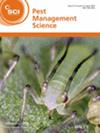求助PDF
{"title":"Exploration of the potential of a boosted sterile insect technique to control fruit flies in mango orchards","authors":"Esther Gnilane Diouf, Thierry Brévault, Saliou Ndiaye, Cyril Piou","doi":"10.1002/ps.8248","DOIUrl":null,"url":null,"abstract":"BACKGROUNDAn innovative version of the sterile insect technique (SIT) for pest control, called boosted SIT, relies on the use of sterile males coated with a biocide to control a target wild pest population of the same species. The objective of the present study was to assess the relevance of such technology to control the fruit fly <jats:italic>Bactrocera dorsalis</jats:italic> and fruit losses in mango orchards using. An agent‐based simulation model named BOOSTIT was used to explore the reduction of fruit losses thank to sterile male fruit flies control and economic benefits according to different strategies of sterile male release. The simulation considered a landscape of 30.25 ha made up of four mango orchards.RESULTSThe SIT and the boosted SIT reduced fruit losses when releases were made before the mango fruiting period. According to model simulations, releases should be performed at least seven times at 2‐week intervals and with a sterile/wild male ratio of at least 10:1. Considering the benefit/cost ratio (BCR), few releases should be done with a late start date. The BCR showed economic gains from the two control methods, the number of saved fruits and BCR being higher for SIT.CONCLUSIONOur simulations showed that SIT would have better results than the boosted SIT to contribute to an effective control of <jats:italic>Bactrocera dorsalis</jats:italic> at the scale of a small landscape. We highlight the need for laboratory studies of other types of pathogen to find a suitable one with higher incubation time and lower cost. © 2024 Society of Chemical Industry.","PeriodicalId":218,"journal":{"name":"Pest Management Science","volume":null,"pages":null},"PeriodicalIF":3.8000,"publicationDate":"2024-06-24","publicationTypes":"Journal Article","fieldsOfStudy":null,"isOpenAccess":false,"openAccessPdf":"","citationCount":"0","resultStr":null,"platform":"Semanticscholar","paperid":null,"PeriodicalName":"Pest Management Science","FirstCategoryId":"97","ListUrlMain":"https://doi.org/10.1002/ps.8248","RegionNum":1,"RegionCategory":"农林科学","ArticlePicture":[],"TitleCN":null,"AbstractTextCN":null,"PMCID":null,"EPubDate":"","PubModel":"","JCR":"Q1","JCRName":"AGRONOMY","Score":null,"Total":0}
引用次数: 0
引用
批量引用
探索昆虫不育增殖技术控制芒果园果蝇的潜力
背景 用于害虫控制的昆虫不育技术(SIT)的一个创新版本称为增殖 SIT,它依赖于使用涂有杀菌剂的不育雄虫来控制同一物种的目标野生害虫种群。本研究的目的是评估这种技术对控制果蝇和芒果园果实损失的相关性。研究人员使用了一个名为 BOOSTIT 的代理模拟模型,来探讨不育雄果蝇控制所带来的果实损失减少情况,以及不同不育雄果蝇释放策略所带来的经济效益。结果当在芒果结果期之前释放不育雄果蝇时,不育雄果蝇和增殖不育雄果蝇可减少果实损失。根据模型模拟,释放至少应进行七次,每次间隔两周,不育/野生雄性比率至少为 10:1。考虑到效益/成本比(BCR),开始时间较晚的释放次数应该很少。我们的模拟结果表明,在小型景观范围内,释放小袋鼠比释放增殖小袋鼠效果更好,有助于有效控制背腹扁虱。我们强调有必要对其他类型的病原体进行实验室研究,以找到一种培养时间更长、成本更低的合适方法。© 2024 化学工业协会。
本文章由计算机程序翻译,如有差异,请以英文原文为准。


